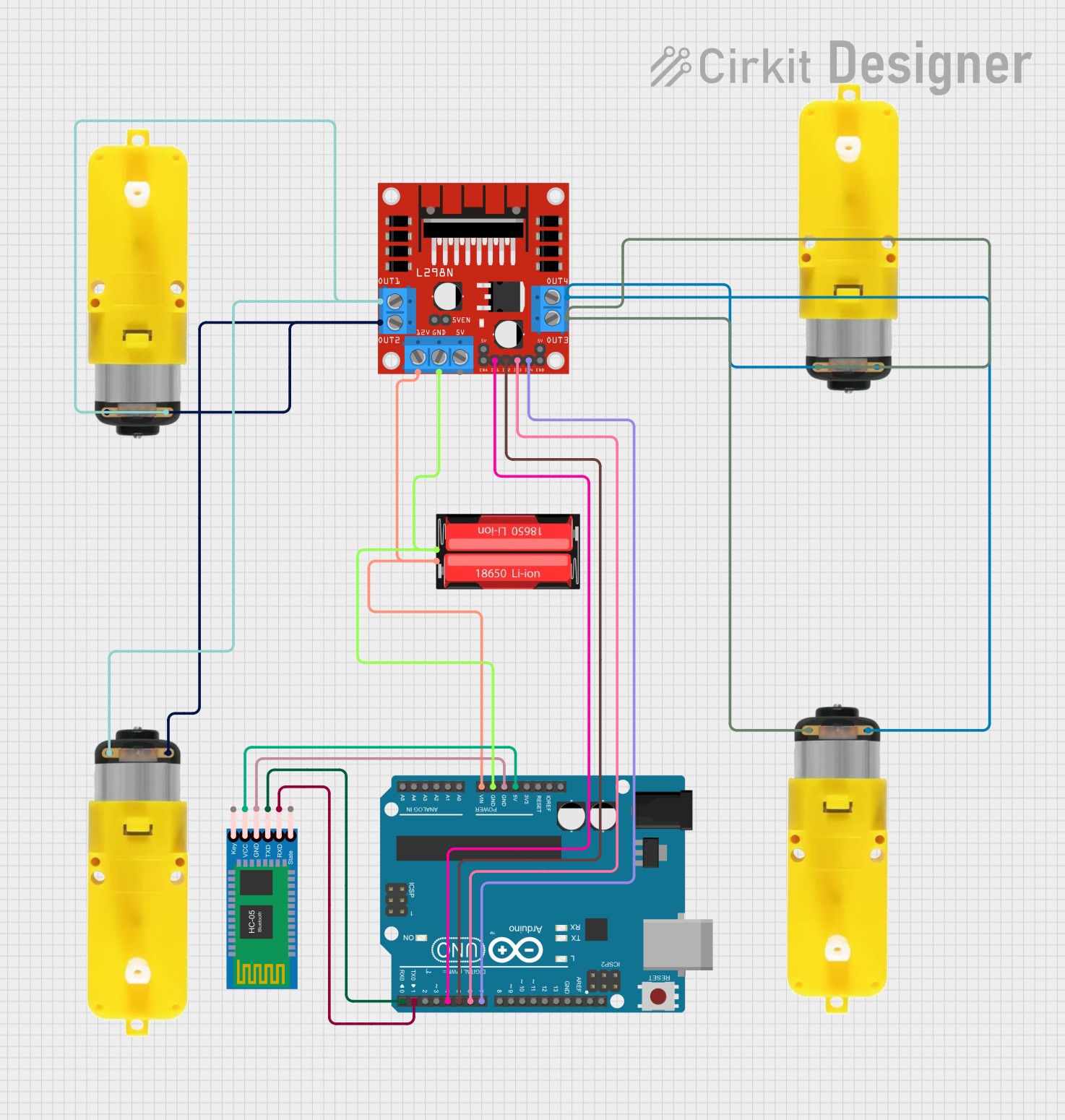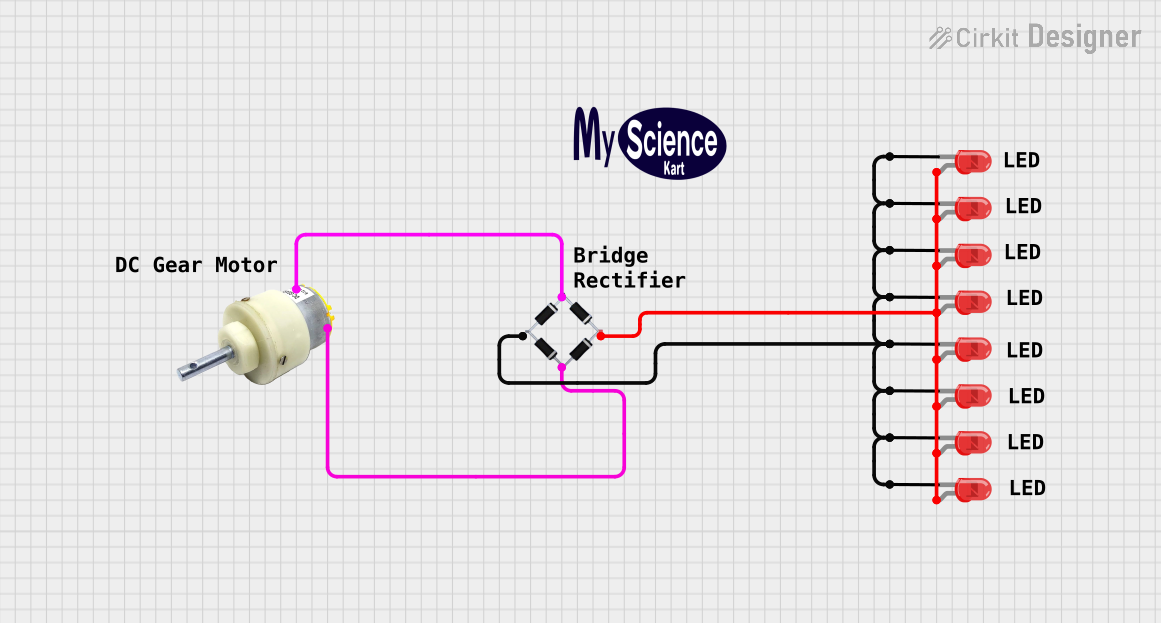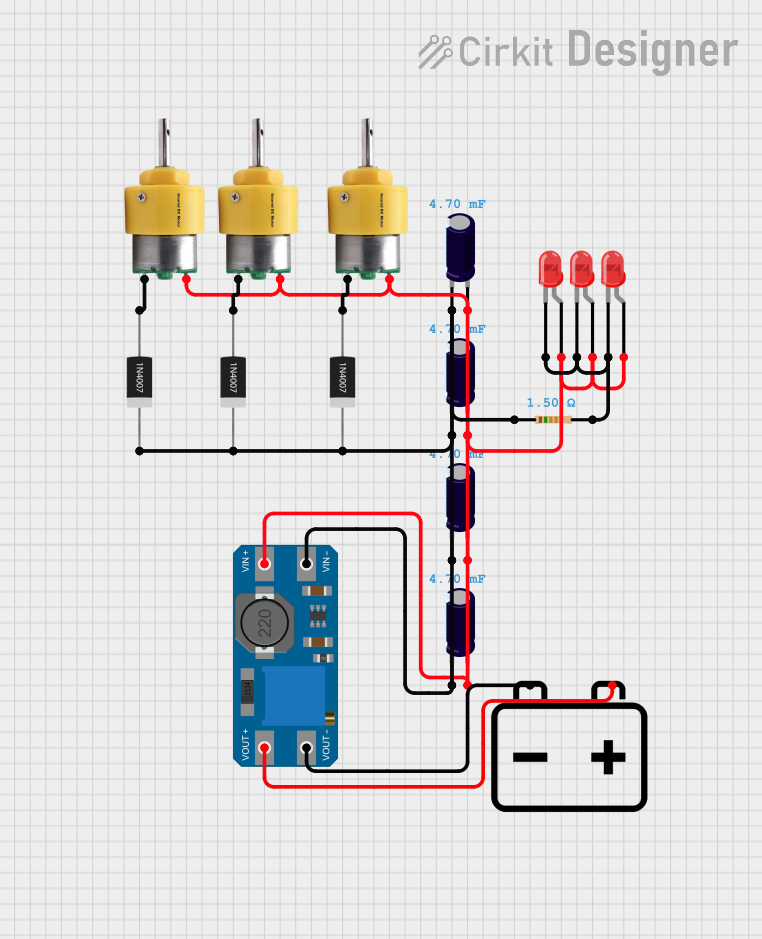
How to Use Motor with reducer: Examples, Pinouts, and Specs

 Design with Motor with reducer in Cirkit Designer
Design with Motor with reducer in Cirkit DesignerIntroduction
A motor with reducer, also known as a geared motor or reduction motor, is an integrated device that combines an electric motor with a gear reduction system. The primary function of this component is to decrease the speed and increase the torque output from the motor to suit specific application requirements. This makes it an ideal choice for applications where high torque at low speeds is necessary, such as in conveyor belts, automation systems, robotics, and various mechanical and industrial processes.
Explore Projects Built with Motor with reducer

 Open Project in Cirkit Designer
Open Project in Cirkit Designer
 Open Project in Cirkit Designer
Open Project in Cirkit Designer
 Open Project in Cirkit Designer
Open Project in Cirkit Designer
 Open Project in Cirkit Designer
Open Project in Cirkit DesignerExplore Projects Built with Motor with reducer

 Open Project in Cirkit Designer
Open Project in Cirkit Designer
 Open Project in Cirkit Designer
Open Project in Cirkit Designer
 Open Project in Cirkit Designer
Open Project in Cirkit Designer
 Open Project in Cirkit Designer
Open Project in Cirkit DesignerTechnical Specifications
General Specifications
| Specification | Description |
|---|---|
| Motor Type | DC/AC (Specify type) |
| Rated Voltage | XX V |
| Rated Current | XX A |
| Output Power | XX W |
| Gear Ratio | XX:1 |
| No-load Speed | XX RPM |
| Rated Torque | XX N·m |
| Efficiency | XX % |
| Insulation Class | Class X |
| Operating Temperature | -XX to XX °C |
Pin Configuration and Descriptions
| Pin Number | Description |
|---|---|
| 1 | Motor Power (+) |
| 2 | Motor Power (-) |
| 3 | Encoder A (if applicable) |
| 4 | Encoder B (if applicable) |
| 5 | Hall Sensor Vcc (if applicable) |
| 6 | Hall Sensor GND (if applicable) |
| 7 | Hall Sensor Output (if applicable) |
Note: The pin configuration may vary based on the specific model of the motor with reducer. Please refer to the manufacturer's datasheet for exact details.
Usage Instructions
Integration into a Circuit
- Power Supply: Connect the motor power pins to a suitable power supply, ensuring that the voltage and current ratings match the motor's specifications.
- Control Interface: If the motor includes an encoder or hall sensors, connect these to the appropriate inputs on your control system.
- Mounting: Secure the motor with reducer to your application, ensuring that the mounting aligns with the gearbox and does not strain the motor shaft.
Best Practices
- Always verify the power requirements and ensure that the power supply is capable of providing the necessary current at the rated voltage.
- Use appropriate wire gauge for the motor connections to handle the expected current draw.
- If the motor is reversible, ensure that the control circuitry can handle the direction change without causing electrical issues.
- Implement proper cooling if the motor is expected to operate near its maximum power rating for extended periods.
- Regularly inspect gears and bearings for wear and lubricate as necessary.
Troubleshooting and FAQs
Common Issues
- Motor Does Not Start: Check power supply connections and voltage levels. Ensure that the motor is not overloaded or jammed.
- Excessive Noise or Vibration: Inspect the gear reducer for misalignment or wear. Check for loose mounting screws.
- Overheating: Ensure that the motor is not being overdriven. Check for adequate ventilation and consider adding a cooling system if necessary.
FAQs
Q: Can I control the speed of the motor with reducer? A: Yes, speed control can be achieved through voltage regulation, pulse-width modulation (PWM), or using a motor controller with feedback from an encoder if available.
Q: What is the lifespan of a motor with reducer? A: The lifespan depends on the usage conditions, load, duty cycle, and maintenance. Refer to the manufacturer's specifications for estimated lifespan under typical conditions.
Q: Can I use this motor with an Arduino UNO? A: Yes, you can control the motor using an Arduino UNO with an appropriate motor driver shield or module.
Example Arduino Code
#include <Arduino.h>
// Define motor control pins
const int motorPin = 3; // Connect to motor driver input
void setup() {
pinMode(motorPin, OUTPUT);
}
void loop() {
// Rotate motor at full speed
analogWrite(motorPin, 255); // Send PWM signal to motor driver
delay(2000); // Run for 2 seconds
// Stop motor
analogWrite(motorPin, 0); // Stop PWM signal
delay(1000); // Stop for 1 second
// Rotate motor at half speed
analogWrite(motorPin, 127); // Send PWM signal at 50% duty cycle
delay(2000); // Run for 2 seconds
// Note: Ensure that the motor driver is compatible with the PWM frequency
// and voltage levels provided by the Arduino UNO.
}
Note: The above code is a simple example to demonstrate motor control with an Arduino UNO. In practice, you would need to use a motor driver compatible with the motor's voltage and current specifications. Additionally, you may need to incorporate feedback mechanisms for precise control.
This documentation provides a basic overview of a motor with reducer. For more detailed information, consult the manufacturer's datasheet and application notes.